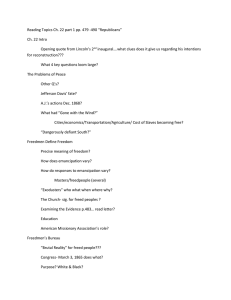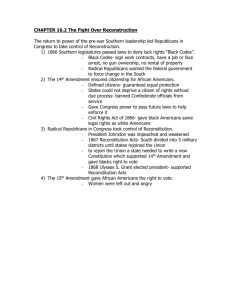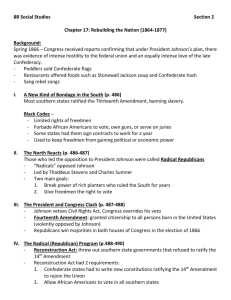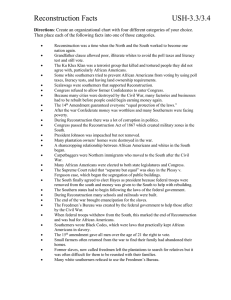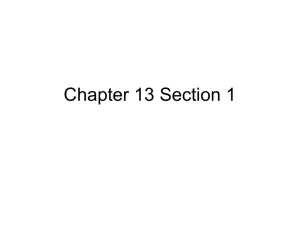Planning Reconstruction Section 1 * 514-519
advertisement
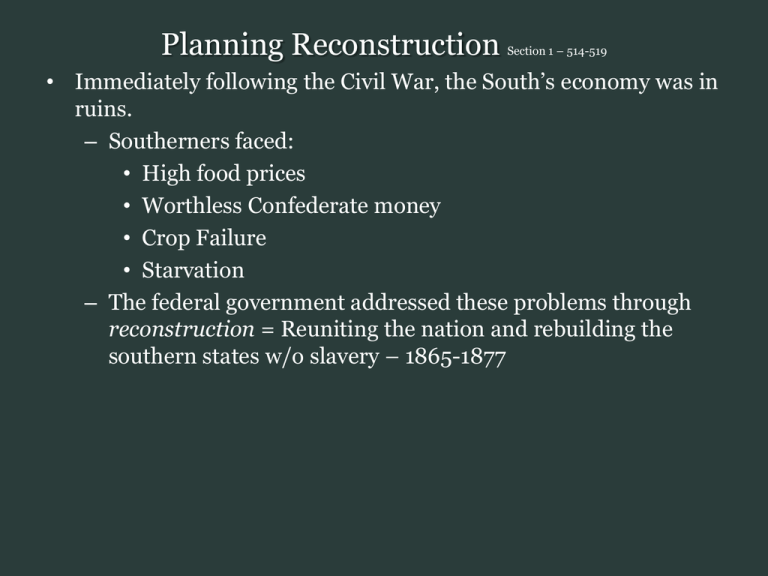
Planning Reconstruction Section 1 – 514-519 • Immediately following the Civil War, the South’s economy was in ruins. – Southerners faced: • High food prices • Worthless Confederate money • Crop Failure • Starvation – The federal government addressed these problems through reconstruction = Reuniting the nation and rebuilding the southern states w/o slavery – 1865-1877 Planning Reconstruction • Lincoln wanted to reunite the nation as quickly and painlessly as possible. – He proposed amnesty = an official pardon, for illegal acts supporting the rebellion. • For southerners to receive amnesty they had to: – Swear an oath of loyalty to the U.S. – Accept a ban on slavery. Planning Reconstruction • Once 10% of the voters in a state accepted the amnesty requirements, they could form a new government. – After the new government had been formed, the state could be readmitted to the Union. – Lincoln’s proposal became known as the Ten Percent Plan. • Louisiana became the first state to accept Lincoln’s proposal. Planning Reconstruction • Some members of Congress disagreed with Lincoln’s 10% Plan. – Senator Benjamin Wade and Congressman Henry Davis proposed an alternative known as the Wade-Davis Plan (WD). • The W-D had two requirements: – A complete ban on slavery. – A majority (at least 51%) of the white males in the state had to take the loyalty oath. • W-D made it much more difficult for southern states to rejoin the union – Lincoln refused to sign the bill. The Thirteenth Amendment • The Emancipation Proclamation had freed slaves in Confederate states, not in border states where slavery continued. – Lincoln urged Congress to make slavery illegal throughout the U.S. • December, 1865 Congress ratified the Thirteenth Amendment which officially made slavery illegal in the U.S. The Thirteenth Amendment • Many Abolitionists felt that the 13th Amendment was not complete. – African Americans still didn’t have the right to vote. • However, the 13th did allow many freedoms such as: – Legalized marriages – The ability to move more freely and to search for relatives The Freedmen’s Bureau • In 1865 Congress established the Freedmen’s Bureau (FB). Its purpose was to provide relief for all people – black and white, in the South. • The FB was responsible for: – Distributing food to the poor. – Supervising labor contracts between freedpeople and their employers. – Assisting African Americans war veterans in receiving veteran’s benefits. – Promoting education • Provided books and teachers A New President • On April 14, 1865 President Lincoln was shot by John Wilkes Booth while watching a play at Ford’s Theatre in Washington DC. – President Lincoln died the next day. • Vice President Andrew Johnson was sworn into office later that morning. President Johnson’s Reconstruction Plan • Johnson’s plan called for designing a system for setting up new state governments. – Each state was appointed a temporary governor. – Each state’s citizens who had taken a loyalty oath would elect delegates to a convention that would revise that state’s constitution. – Voters would elect new state officials and representatives to the U.S. Congress. – Declare that secession was illegal. – Refuse to pay any Confederate war debts President Johnson’s Reconstruction Plan • By the end of 1865 all southern states except for Texas had created new governments. – Johnson declared that the U.S. was restored. – The newly elected congressional representatives travelled to Washington, but Congress refused to allow them to take their seats. • Republicans complained that: – Many of the southern representatives had been military leaders and political leaders in the Confederacy. » Many Republicans felt that those reps. were not loyal to the U.S. » The U.S. was still divided. The Black Codes Section 2 – 520-526 • As southern states were readmitted to the Union, each state’s legislature began creating Black Codes (BC)= laws that limited the freedom of African Americans. – BCs required African Americans to sign work contracts • Working conditions were similar to those experienced during slavery. – African Americans had to prove they were employed or they could be arrested. – African Americans couldn’t own guns or rent property in cities. The Radical Republicans • Most Republicans in Congress were concerned that the Black Codes were an indication that the South was returning to its old ways. – They felt that the BCs were cruel. – Some of these Republicans became known as Radical Republicans (RR) b/c they wanted the southern states to change much more. • RRs feared that too many southern leaders were still loyal to the former Confederacy. • RRs wanted economic and political justice for African Americans and poor white southerners. Johnson versus Congress • In early 1866 Congress proposed a bill to give the Freedmen’s Bureau more power. – Johnson vetoed the bill and insisted that Congress could not pass any new laws until southern states were represented in Congress. • Congress responded with the Civil Rights Act of 1866 = African Americans were to have the same legal rights as white Americans. – Johnson vetoed this bill as well, claiming that it would give too much power to the federal government. » Johnson also rejected the idea of equal rights for African Americans. He said that they didn’t understand how our country and government was run. » Congress overrode his veto. The Fourteenth Amendment • The Republicans in Congress wanted to protect civil rights from hostile presidents, courts, and/or future legislators. – In the summer of 1866, Republicans proposed the Fourteenth Amendment. Its main provisions are: • U.S. citizenship = born or naturalized w/in the U.S. – American Indians were not considered citizens. • Citizens would receive equal protection of law. • All states must provide due process of law. Congress Takes Charge • In the spring of 1867, Congress passed the first of several Reconstruction Acts (RA). – These laws divided the South into five districts with a military commander in charge of each district. • The military would remain in the South until the southern states rejoined the Union. The requirements to rejoin were: – Write a new constitution supporting the 14th Amendment. – Give African American men the right to vote. Congress Takes Charge • President Johnson disagreed with the RA. – He argued that African Americans did not deserve the same treatment as white people. – Since the Republican party held a two-thirds majority in both houses of Congress, they were able to override Johnson. • The Republican majority also passed a law to further limit the president’s power by not allowing him to remove cabinet officials w/o the Senate’s approval. – Johnson broke the law by firing his secretary of war. Congress Takes Charge • The HOR responded to Johnson’s action by voting to impeach him. – The Senate still needed to have a two-thirds vote for Johnson to be removed. • Although Johnson was unpopular with many Republicans, some thought he was being treated unfairly. – By a single vote, the Senate failed to convict Johnson; though his career in politics was ruined. The Election of 1868 • Republican candidate Ulysses S. Grant won the 1868 presidential election. – He supported the congressional reconstruction plan and ran under the slogan “Let us have peace.” – Shortly after Grant’s nomination, Congress readmitted seven southern states. • These states approved the 14th Amendment and agreed to allow African American men the right to vote. – Many white southerners used violence to keep African Americans away from the polls. » Still, hundreds of thousands of African Americans voted for Grant. The Fifteenth Amendment • Many Republicans in Congress wanted to protect their Reconstruction plan. – They were concerned about future Congresses trying to change it. – They felt it was not fair that many northern states had laws that prevented African Americans from voting. • All southern states were required to allow African Americans to vote if they wanted to be readmitted to the Union. – Congress proposed the Fifteenth Amendment in 1869. • All African American men throughout the U.S. had the right to vote. – Women, whatever their race, still could not vote. Reconstruction Governments Section 3 – 527-532 • After the war, some northern-born Republicans moved to the South. – Southerners called these people carpetbaggers b/c many carried their possessions in bags made from carpeting. • Many southerners resented the carpetbaggers b/c they felt that they had moved south to profit from the Reconstruction. • Some northerners wanted to help former slaves while others were there to make money. • Southern Democrats referred to southern Republicans as scalawags = mean fellows, b/c they believed the scalawags had betrayed the South by supporting the Republicans. Opposition to Reconstruction • Most white southerners opposed Reconstruction. – Southern Democrats claimed that Reconstruction governments were corrupt. – They disliked having federal troops in their states. – They disapproved of African American social, working, and political freedoms. • Tennessee, 1866 – Ku Klux Klan (KKK)= A secret society opposed to civil rights, particularly suffrage for African Americans. – The KKK used terror and violence against African Americans, and their white supporters. The End of Reconstruction • Actions that challenged Reconstruction: – General Amnesty Act of 1872 = Former Confederates were allowed to hold public office. • Most were Democrats who opposed Reconstruction. – The Republican party lost its majority control of Congress in 1874. – Panic of 1873 = A severe economic depression in which two million Americans were out of work. • The Republicans were blamed for that depression. The End of Reconstruction • Rutherford B. Hayes was elected as president in 1876. – Hayes and the Republicans decided that it was time to end federal support of reconstruction. • In 1877, the last of the federal troops were removed from the South. Jim Crow and Plessy v. Ferguson • After the Reconstruction period, Democrats began to gain control of state governments in the South. – These Democrats became known as Redeemers. • Goals of the Redeemers: – Reduce the size of state government, social programs, and public funding for schools – Limit African American rights » Poll Tax = a tax people had to pay b/f they could vote. » Literacy Test = a test that required a certain reading ability b/f they could vote. – Cut property taxes Jim Crow and Plessy v. Ferguson • The Redeemers also introduced legal segregation = the forced separation of whites and African Americans in public areas. – Jim Crow Laws = Laws that required segregation and were common in the southern states from the 1880’s – 1964. • Early examples of Jim Crow segregation: – Hotels, Trains, Theaters, Places of employment • Later examples: – Water Fountains and Restrooms, Public Transportation, Restaurants, Stadiums Jim Crow and Plessy v. Ferguson • In 1896, the case of Plessy v. Ferguson was heard by the Supreme Court. – Homer Plessy, an African American, was arrested after he refused to leave the white-only section on a Louisiana train. • LA’s Jim Crow laws did not allow African Americans to ride in train cars with whites. • The Supreme Court ruled that segregation was allowed if “separate-but-equal” facilities were provided for African Americans. – In practice, separate-but-equal facilities were separate and unequal. Sharecropping Section 4 – 533-537 • Few African Americans in the South could afford to buy or rent farms. – Many remained on the same plantations where they were once slaves. • They worked for much less pay than whites did and were treated harshly. • The landowner provided the land, tools, and supplies while the sharecropper provided the labor. – Most of the crop went to the landowner and the sharecropper got whatever was left. Sharecropping • Most sharecroppers hoped to earn enough money from the sale of their share so that they could buy their own land. – Few ever did and sunk deeper into debt with each passing season. Southern Industry • The southern economy prospered and declined as the price of cotton rose and fell. – Southern business leaders felt that creating industry would strengthen the South’s economy. • The South had an abundance of two resources – cotton and cheap labor. – Textile mills were built and in turn helped boost the southern economy. Southern Industry • With the creation of southern textile mills came the creation of jobs. – Many people from rural areas came to work in the mills, however most mills would not hire African Americans. • Often, entire families worked in the mills including children by the age of 12. • Mills offered: – Steady pay and steady work. – Six day work weeks, 12 hours/day. – Cotton dust and lint filled air = asthma and brownlung disease. Southern Literature and Music • As the South began to modernize, many southerners looked to the arts to preserve their longstanding traditions. – Authors such as Mark Twain and Mary Murfree wrote short stories and novels about southern people and places. – Musicians played the fiddle, banjo, and guitar. • These instruments were and are still especially popular for square dancing and Bluegrass music. • All information for this PowerPoint taken from Holt “Call to Freedom” 2004



